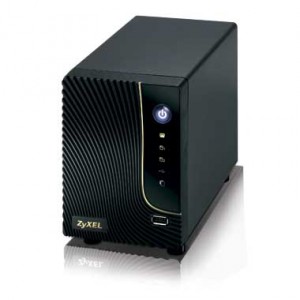
I recently purchased a ZyXEL NSA320 to use in upgrading my home server infrastructure. I plan to replace the capable, easy to use, stock firmware with Debian linux.
The NSA320 is a small, low power server based on an “Kirkwood” ARM SoC from Marvell, paired with 512MB of RAM and gigabit ethernet in a small case that accepts two 3.5″ hard disks. It runs a linux-based firmware that provides file sharing, media streaming, and a variety of other features. The NSA320 is one of many low- and mid-priced products based on the Kirkwood family of chips, which first gained attention in the SheevaPlug.
The NSA320’s SheevaPlug pedigree is significant, because when the SheevaPlug debuted 4 years ago, it offered a unique combination of price, performance, capability, compactness, and openness. Up to that point, if you wanted an open platform, your options were x86 PC derivatives, which were larger, more expensive and consumed more power. If you wanted compact and low-power in x86, you had options, but they were 2x the price of the Sheevaplug.
ARM, MIPS and other RISC based options were available, but pricing was aimed at professional developers of embedded devices and wasn’t attractive for hobbyists. The embedded platforms had other issues as well. The dev-envronments took time and/or money to get working, and the platforms were often encumbered by NDAs. They also tended to be less capable than the Sheevaplug, with limited RAM and Flash, slower processors and less capable networking. Interestingly, these platforms ended up generating a lot of interest from hobbyists, but their attention was focused on the products, rather than the development tools; they hacked routers to run custom firmwares, like Tomato and OpenWRT.
The Sheevaplug was $99, which put it in the same price range as many of the commercial devices people were hacking. It also had a 1.2GHz CPU and 512MB RAM and it ran mainstream linux distributions like Debian, which mean that people could easily compile their code right on the device.
Of course, the Sheevaplug spawned its own family of inexpensive commercial products based on the Kirkwood SoC, like the PogoPlug family, and, perhaps more importantly, the PogoPlug based Seagate Dockstar. The Dockstar is significant because Seagate seems to have overestimated demand and then was left with a vast amount of inventory that ended up selling at a deep discount, with some going for less than $25.
The availability of cheap, capable Kirkwood devices, and the relative openness of the platform, has spawned multiple communities of people adapting software to enhance the capability of the devices, which is why I ended up buying the ZyXEL NSA320. The NSA320 stood out for me because its compact case can accommodate two SATA hard disks which offers a tidier, better performing solution than the external hard disks hooked to my Debian-running Dockstar. There are a number of other Kirkwood based dual-SATA NAS boxes, but the tend to be both more expensive (The NSA320 sells for $110, and is often available on sale for less than $90) with less capable hardware (the NSA320 has 512MB RAM, most of the other options have 128MB) or 256MB.
So, that’s a little context on why I found the NSA320 interesting. Next, I’ll be sharing links to the resources I’ve found on customizing the NSA320, and I’ll try to distill down some of what I’ve learned to make it easier for those who come after me.
Pingback: My costly mistakes on the path to a somewhat inexpensive home server | Tech Obsessed
Pingback: Berries, Bananas, Oranges and C.H.I.P.s | Tech Obsessed